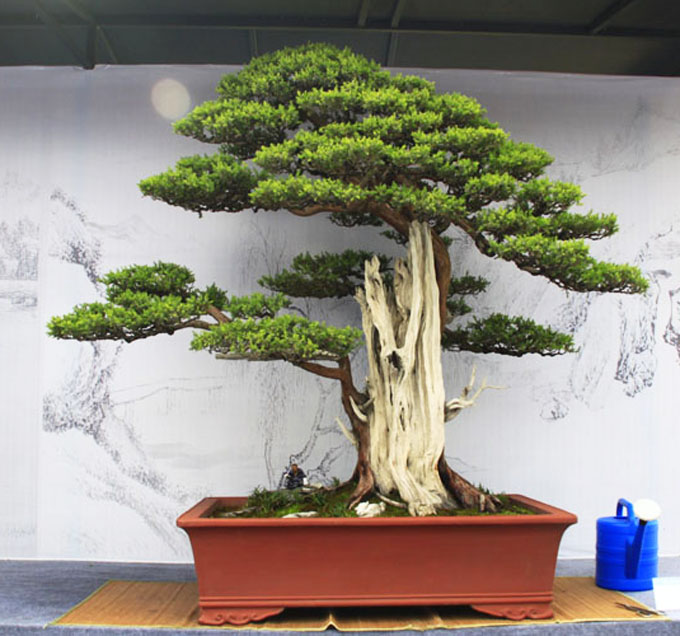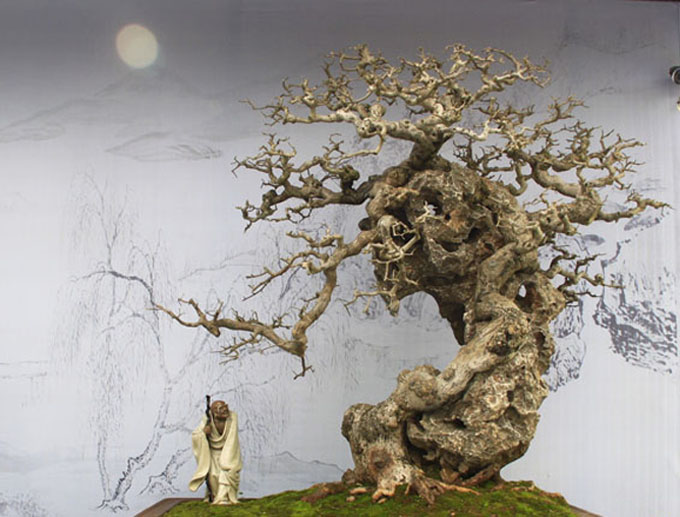 What appear to be roots growing out of a long hollow on the side of trunk, creates a very unusual and fascinating effect. The rest of the tree isn’t half bad either and the flute player adds a playful human quality and contributes to a sense of vastness. The photo, which is courtesy of Robert Steven is from the recent BCI convention in China
What appear to be roots growing out of a long hollow on the side of trunk, creates a very unusual and fascinating effect. The rest of the tree isn’t half bad either and the flute player adds a playful human quality and contributes to a sense of vastness. The photo, which is courtesy of Robert Steven is from the recent BCI convention in China
This post, like the previous post titled BCI: Bonsai Strong, shows more of Robert Steven‘s photos from the recent BCI convention in China. As you may know, in addition to being a great bonsai artist, Robert is also an expert on bonsai and bonsai history, with a strong bent towards Chinese bonsai and penjing. Here’s what he wrote about Chinese bonsai in the comments to the aforementioned post (squeezed into native speaker English by yours truly) “Chinese bonsai has seen amazing progress the last 15 years, but it wasn’t very well exposed till the last few years (through aggressive international events). They are coming out with very creative and refreshing designs, and ideas present no limits for them. At the same time, I dare to say the Japanese are in stagnation. I anticipate a change in worldwide bonsai orientation that will turn to China…”
One thing I noticed about the pines in the previous BCI post, is how much they seemed to be influenced by Japanese bonsai while at the same time being quite unique, not to mention extraordinarily powerful. On the other hand, the broad leaf trees in this post seem much more Chinese to my eyes. That’s not to say that they don’t express new and exciting ideas (they do), just that they also reflect a very traditional Chinese style. This is especially true of the tree above and the last three trees below
Something else you might notice about the trees shown here is that every one of them has a figurine, while non of the pines shown in the previous BCI post have any.
 This large bonsai (with blue watering can) features another fascinating trunk. Though it’s impossible to tell (for me at least) the leaves look like they might be azalea.
This large bonsai (with blue watering can) features another fascinating trunk. Though it’s impossible to tell (for me at least) the leaves look like they might be azalea.
 Even though they are broad-leaf trees, their towering vertical thrust is reminiscent of a conifer grove high in the mountains of the western U.S.
Even though they are broad-leaf trees, their towering vertical thrust is reminiscent of a conifer grove high in the mountains of the western U.S.
 Windswept bonsai with hitchhiker. This one reminds of some of Robert’s trees.
Windswept bonsai with hitchhiker. This one reminds of some of Robert’s trees.
 The big guy almost looks like a rock. Nice tree too.
The big guy almost looks like a rock. Nice tree too.
 At the risk of getting carried away, how about ‘wandering sage stops for a moment to contemplate an ancient tree by the light of the moon.’ In any case, I don’t blame him. You don’t see trunks (or trees) like this one every day.
At the risk of getting carried away, how about ‘wandering sage stops for a moment to contemplate an ancient tree by the light of the moon.’ In any case, I don’t blame him. You don’t see trunks (or trees) like this one every day.

Wayne:
Wow! Stevens’ photos of the China BCI trees depict some extraordinary bonsai. The ART of bonsai, its beauty and delicacy, is very much alive and well.
Thank you, Wayne.
Is the tree in that last photo, (Wandering Sage), a root-over-rock? It’s hard to tell because the color and texture of the root and the rock are so similar.
This makes you wonder if your somebody ( like me) who may go and commit to an aprenticeship in the future, is it worth doing at least part of it in China for proffesional reason’s at least? I mean if China is going to take over as the ” in ” style, having that training on your resume may make you more employable.
I used to be very much a supported of the Japanese ‘style’ of bonsai but since meeting Robert and reading his books and comments on Bonsai Bark and Facebook I’m much more in favour of the Penjing style these days. The trees above are fabulous.
Will, it is kind of rock over rock.
Elliott, An,
Despite of being influenced by the Chinese “styles”, learning the aesthetic concept and philosophy of Chinese penjing will open our mind to broader perspective of what we learned about bonsai, to unlimited our creativity based on the true oriental arts. It will also change our way to appreciate the art, not simply look at the art but we will be able to sense with our inner feeling. Yet, we need to open our heart to understand and see with our inner eyes…and we will find the hidden soul.
(sound absurd but it’s real…)
WOW ! its a treat even to watch the pictures .. totally perfected pieces of art ..Cannot forget the backdrop , the lighting the figurines .. really marvelous..
So much I would like to say/ hear /share with Robert and his “like” , distance and age make the possibility remote .So his books and such photo,s and features at least show the movement he shows towards ” natural images ” that are in tune with my soul and the soul of nature .My feeling has been fro many years that the “technical brilliance ” of Japanese Bonsai ” craftsmen”may have led to wonderful woodwork creations .But the soul essence of that which to me is bonsai [ penjing ].were left far behind .With China,s resurgence we may be seeing again a lead being given which takes us in time towards rootedness .Taoist in conceptual terms and not understood in my part of the world by many , even in Bonsai.
Thanks Anthony,
I think the problem is the mind-set. Many people are using too much their logic to the rigid discipline of the Japanese, perceived the wrong way to the convention; while the Chinese are using their other art forms as basic references to their bonsai designs without limitation of “rules”, such as painting, calligraphy, poem..and their inner sense…